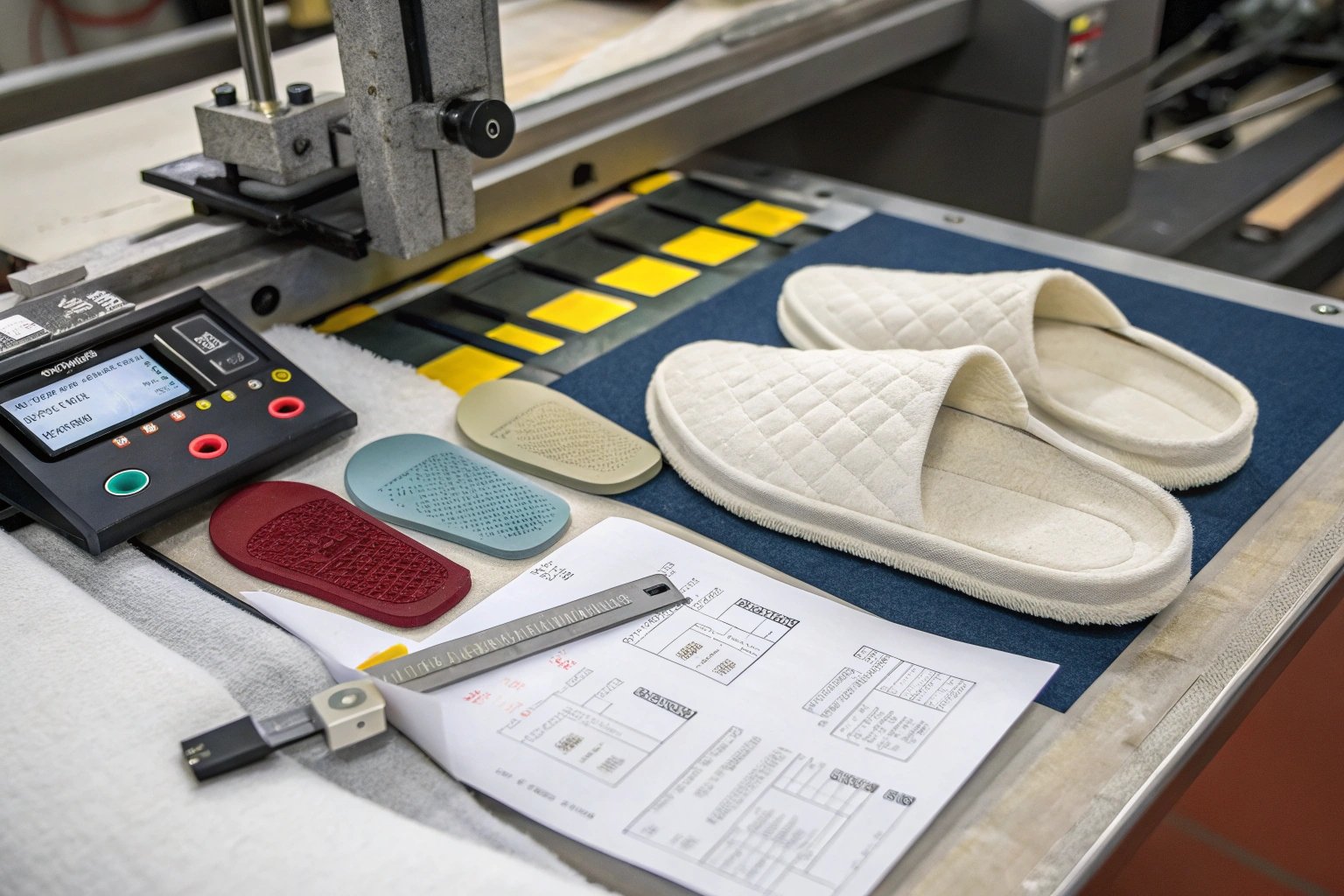Are your slippers falling apart too soon? Material stability is key to making slippers that last.
Controlling material stability in slipper mass production involves carefully selecting, testing, and handling materials to ensure consistent quality and durability.

So, how do we ensure the slippers we produce don’t lose their shape or fall apart after just a few uses? Let’s dive into the specifics of material stability.
How to select stable materials for slipper production?
Are you wondering what makes a slipper material "stable"? It’s about picking materials that hold up under stress.
Selecting stable materials means choosing those resistant to stretching, shrinking, and deformation over time. This includes factors like wear resistance, colorfastness, and resistance to temperature changes.

Dive deeper:
When I’m selecting materials, I look for specific features. First, I consider the type of slipper. Is it for indoor use, outdoor use, or both? This will greatly impact my choice of materials. For indoor slippers, I might focus on soft, comfortable materials like cotton or wool blends. But, for outdoor slippers, I will prioritize durable, weather-resistant materials like EVA plastic or treated fabrics.
Next, I examine the material’s wear resistance. This involves testing how well the material holds up against abrasion and friction. I look for materials that can withstand daily wear and tear without showing signs of damage or degradation. Also, colorfastness is important, especially for slippers that will be exposed to sunlight or water. I ensure the materials I choose retain their color and don’t fade or bleed over time. Another critical aspect is resistance to temperature changes. Materials that can withstand temperature fluctuations without warping or cracking are ideal. For instance, EVA plastic is great for its flexibility and resistance to cracking in cold weather.
Here’s a simple table that I often use:
| Material | Wear Resistance | Colorfastness | Temperature Resistance | Ideal Use Case |
|---|---|---|---|---|
| Cotton Blend | Medium | Good | Medium | Indoor slippers, comfort focused |
| Wool Blend | High | Excellent | High | Indoor/outdoor, warmth and comfort |
| EVA Plastic | High | Good | Excellent | Outdoor, waterproof |
| Treated Fabrics | High | Excellent | High | Versatile, various uses |
How to test materials for stability?
Worried about how a material will perform in the long run? Testing can give you the answers you need.
Testing materials involves subjecting them to stress tests like elongation tests, weathering tests, and abrasion tests to ensure they meet desired stability standards.

Dive deeper:
The testing phase is crucial for me. It’s where I confirm whether the materials I’ve chosen meet the required stability standards. The elongation test, for example, measures how much a material can stretch before it breaks or deforms. This test is essential for ensuring that the slippers can withstand regular use without losing their shape. Weathering tests simulate exposure to environmental factors like sunlight, moisture, and temperature changes. I use these tests to assess how the material will hold up over time under different conditions.
Abrasion tests are performed to evaluate the material’s resistance to wear and tear. This involves rubbing the material against a rough surface to see how quickly it shows signs of damage. This is particularly important for slippers that will be used on rough surfaces. I also conduct colorfastness tests to check if the dye will bleed or fade with use. Materials that pass these tests are more likely to maintain their appearance over time. Here’s a summary of some common tests I perform:
| Test Type | Purpose | Key Metrics Measured |
|---|---|---|
| Elongation Test | Determine stretch resistance | Maximum elongation before break |
| Weathering Test | Simulate environmental exposure | Color fade, material degradation |
| Abrasion Test | Evaluate wear resistance | Material loss, surface damage |
| Colorfastness Test | Check dye bleeding or fading | Color change after washing/rubbing |
These tests ensure that the materials I select for slipper production are durable, reliable, and meet the standards of CE, RoHS, REACH, EN ISO 13287.
How does proper storage and handling affect material stability?
Can how you store materials really make a difference? Absolutely!
Proper storage and handling involve maintaining optimal temperature and humidity levels, avoiding direct sunlight exposure, and using appropriate packaging to prevent material degradation.

Dive deeper:
I’ve learned that even the best materials can degrade if not stored correctly. Maintaining optimal temperature and humidity levels is crucial. High humidity can cause materials to warp or develop mold, while excessive heat can cause them to dry out and crack. I always store materials in a cool, dry environment to prevent these issues. Avoiding direct sunlight is equally important. UV rays can cause materials to fade, become brittle, and lose their structural integrity. I ensure that all materials are stored away from direct sunlight.
Using appropriate packaging also plays a key role in preserving material stability. Packaging should protect materials from dust, moisture, and physical damage. I often use sealed bags or containers to keep materials in the best possible condition. I also label all stored materials with information about their properties, storage requirements, and expiration dates. This helps my team handle them correctly and ensures that we’re using the materials before they degrade. Here’s a quick guide to how I manage storage:
| Material Type | Temperature | Humidity | Sunlight Exposure | Packaging |
|---|---|---|---|---|
| Cotton Blends | 15-25°C | 45-55% | Avoid Direct | Sealed Bags |
| Wool Blends | 15-25°C | 45-55% | Avoid Direct | Sealed Bags |
| EVA Plastic | 10-30°C | 50-60% | Avoid Direct | Protective Containers |
| Treated Fabrics | 15-25°C | 40-50% | Avoid Direct | Sealed Bags |
Conclusion
Material stability ensures that our slippers not only look great but also stand the test of time, delivering value and comfort to the end user.

